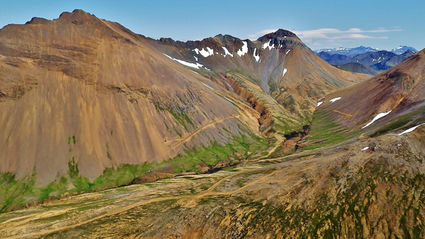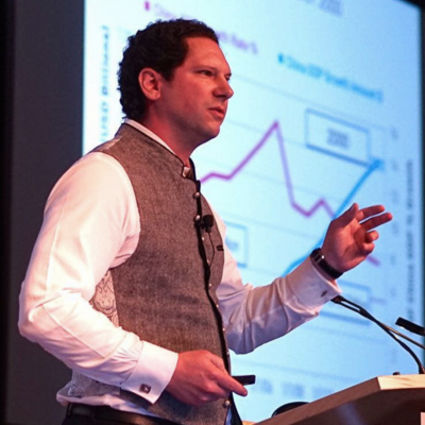Building a "green metal" Pyramid
CopperBank grows resource at Alaska copper-gold project North of 60 Mining News – February 9, 2018
Last updated 9/24/2020 at 6:33pm
With 13 holes drilled in 2017, CopperBank Resources Corp. has added more than 160 million pounds of copper to its Pyramid project on the Alaska Peninsula.
"For a small investment in 2017, our team was able to significantly increase the scale, confidence and quality of the project," CopperBank Executive Chairman Gianni Kovacevic said upon the Feb. 2 release of an updated resource for Pyramid.
Kovacevic has been a strong advocate for copper as a "green metal" that will see exponential growth in demand as an increasing number of devices are powered by electricity.
"I do believe the demand for copper is going to increase in the next 20 years, or thereabouts, by about 50 percent. This is simply due to the intensive electrification of global energy – the way we generate it, the way we transfer it and the way we utilize it," the CopperBank Chairman said during a Jan. 24 interview with Investing News Network.
While electric cars are one component of the electrification of global energy, Kovacevic says you have to look at the entire mix of new energy sources to appreciate what it means for copper.
"The generation of a wind-park, it takes 500 percent more copper, and when you do this offshore it takes 1,000 percent more copper for each megawatt," he said.
Foreseeing a growing need for copper to generate and deliver much of the world's future energy needs, Kovacevic formed CopperBank in 2014 and assembled a trio of projects in Alaska and Nevada that could help supply the future of the vital electricity conduit – especially the company's flagship Pyramid project, which hosts a Pacific Rim copper deposit well situated for delivering into the world's growing copper demand.
"The superior location and ownership structure further demonstrate that Pyramid is one of only a handful of established copper projects that is located on private property in the United States, with the added benefit of being located only four kilometers (2.5 miles) to all-year ice-free deep tidewater," said Kovacevic.
Expanding Pyramid
When CopperBank acquired Pyramid from Full Metal Minerals Ltd., the project hosted 122.5 million metric tons of inferred resource averaging 0.41 percent (1.1 billion pounds) copper, 0.1 grams per metric ton (389,000 ounces) gold and 0.021 percent (56.7 million lb) molybdenum.
While this project was ripe for expansion, in order to protect shareholder value, CopperBank waited for metals markets to begin to recover before investing in the drilling it would take to add to the copper at Pyramid.
With copper prices on the rise and confidence returning to the mining markets, CopperBank launched a 13-hole drill program last year aimed at expanding and upgrading Pyramid.
"This long anticipated drilling program will give our technical team the direction for next steps in the development of the project, and specifically a better view of the higher grade sections of the deposit," said Kovacevic.
The 2017 drilling did tap the copper zones the company was seeking.
Two such holes drilled early in the program – 17PY032 and 17PY033 – cut a broad horizon of continuous, higher grade mineralization across a 400-meter stretch of the Pyramid main zone.
Hole 32 cut three mineralized intercepts: 40 meters of 0.33 percent copper, 0.1 percent molybdenum and 0.07 g/t gold from 11 meters; 51.3 meters of 0.34 percent copper, 0.02 percent molybdenum and 0.1 g/t gold from 67 meters; and 201 meters of 0.48 percent copper, 0.02 percent molybdenum and 0.1 g/t gold from 132 meters.
Hole 33 cut 300 meters of 0.53 percent copper, 0.12 g/t gold and 0.02 percent molybdenum.
CopperBank said the higher grade portions of these holes are outside the 2013 resource envelope.
Hole DDH 17PY037, which is entirely outside the historical resource, cut 331.6 meters of 0.31 percent copper 0.12 grams per metric ton gold and 0.02 percent molybdenum.
Adding the 3,660 meters drilled this year to the nearly 7,000 meters previously drilled at Pyramid, the project now hosts 153.4 million metric tons of inferred resource averaging 0.37 percent (1.26 billion pounds) copper, 0.09 g/t (457,000 ounces) gold and 0.021 percent (70 million lb) molybdenum.
"The new resource demonstrates that Pyramid has the potential to become a significant deposit in a very good location," said Kovacevic.
"The data acquired as part of this most recent drill program has significantly increased our understanding of the deposit and will additionally help define a follow-on work program at Pyramid in 2018," he added.
Investigating San Diego Bay
While reaffirming Pyramid's potential, CopperBank began to investigate San Diego Bay, a promising but much earlier stage copper target about six miles to the east.
A 15-square-mile red-stained anomaly from the pervasive alteration there indicates the potential of another large porphyry system near or potentially connecting to Pyramid.
Limited exploration completed in the past has turned up some interesting results at San Diego Bay, including rock samples with grades as high as 16 percent copper and more than 1 g/t gold.
Geologists collected 37 grab rock samples and 173 soil samples during the summer program at San Diego Bay.
The soil samples were collected over three areas: San Diego Bay in the southeast; Renshaw Point on the eastern side of the property, and an area near Balboa Bay on the western side of the property.
The best values came from around Balboa Bay where a copper-gold-molybdenum-silver anomaly was traced for 2,700 meters along a northeast trend and an apparent average width of 500 meters. This area covers the gold bearing Oh Boy Vein in its southwestern part. CopperBank said the metal assemblage identified could reflect the presence of a porphyry-style mineralization.
The area sampled near an intrusion at Renshaw Point revealed a soil anomaly of nearly 400 meters in length returning silver values averaging more than 1 gram per metric ton and local gold values over 0.2 g/t along the intrusive contact. The company said more work will be necessary to see if the anomaly is due to the presence of epithermal veins.
The tested area around an intrusion of San Diego Bay returned a single gold anomalous sample and no significant values for other metals of interest.
"The 2017 exploration campaign at San Diego Bay suggests that significant copper and gold mineralization could be present at depth, such as at Pyramid located 10 kilometers (six miles) to the west," said Kovacevic.
Buried structures
To gain a better understanding of what lies below the surface, CopperBank hired Auracle Geospatial Science Inc. to carry out 3D radar models at both Pyramid and San Diego.
Auracle has developed a system that transforms geospatial data captured from satellites, drones, and aircraft into high-resolution visual information about the earth.
By combining radar and optical satellite data, Auracle's proprietary mapping system is able to distinguish geological information below vegetation, ground cover, water, ice, rocks, and soils.
"Auracle's technology works at, near and under the earth's surface enabling it to see through things that no other technology can claim," explains Auracle President and CEO David McLelland.
Using its exclusive algorithms, Auracle extracted strike and dip measurements of the different interpreted structures and produced a series of maps that are expected to help CopperBank target future drilling at Pyramid and San Diego Bay.
"The new data will allow our technical team to better understand the control of mineralization within the vast color anomaly present over the two projects," said Kovacevic. "Zones of interest are standing out that have never been tested at depth."
Looking ahead
Following the success of its 2017 exploration programs at Pyramid and San Diego Bay, CopperBank is putting together plans to have drills turning on the neighboring copper projects.
In a technical that supports the upgraded Pyramid resource, SRK Consulting recommends that CopperBank drill another 10 holes to expand and further delineate the copper mineralization at Pyramid.
If the drilling proves to be a success, SRK recommends a preliminary economic assessment to begin looking at the viability of developing a mine at Pyramid.
CopperBank plans to use the information derived for the Auracle study to help target this initial 2,500-meter drill program.
"As we continue to scrutinize the deposit and follow-up on the numerous areas still open to resource expansion, we are layering in further technical information, such as Auracle's structure density study, to guide our team in future drilling campaigns and important next steps towards more detailed economic studies," said Kovacevic.
CopperBank is considering another 6,000 to 8,000 meters of drilling following the PEA.

CopperBank Resources Corp.
Pyramid, a porphyry deposit on the Alaska Peninsula, hosts 1.26 billion pounds of copper, 457,000 ounces of gold and 70 million lb of molybdenum.
In the meantime, the company is compiling the information it has collected on San Diego Bay into a maiden technical report for the property with the goal of drilling the first holes into the very early staged but exciting copper prospect.
It may not be CopperBank, however, that carries out this drilling.
As a way to maximize the value of San Diego Bay for its shareholders, CopperBank is considering moving the large copper prospective project into a new company. While no definitive plans have been made public, the company indicates this spin-out could happen by the end of March and the new stand-alone company could carry out a 1,000- to 2,000-meter drill program at San Diego Bay later this year.
This move would provide CopperBank shareholders with two companies with Pacific Rim copper projects – one that is beginning to consider the potential of helping to supply the world's growing demand of this green metal and a second that is just beginning to reveal its hidden potential.




















Reader Comments(0)